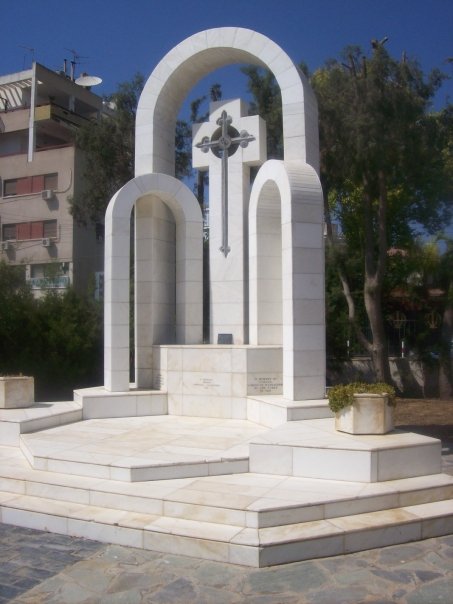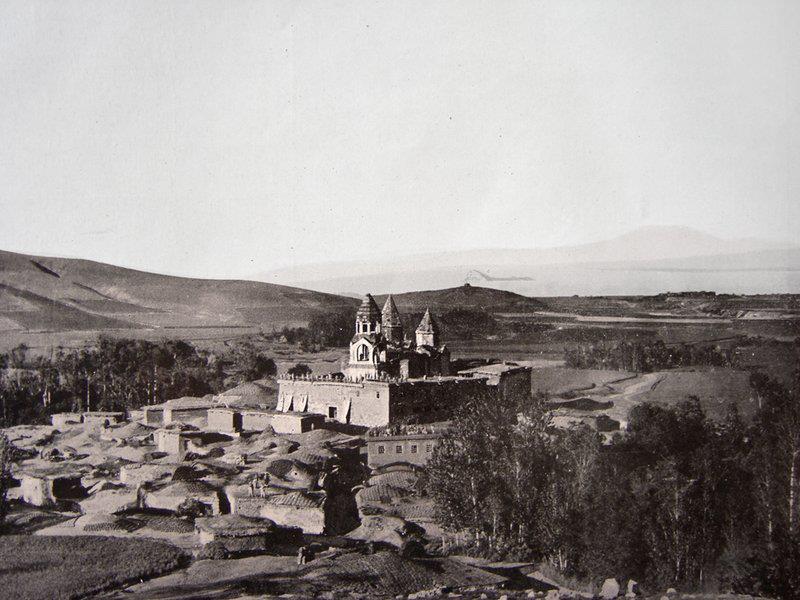|
Armenian Genocide Monument In Nicosia
The Armenian Genocide Monument in Nicosia, Cyprus, is a monument dedicated to the martyrs and the survivors of the Armenian genocide of 1915–1923. It is located within the Armenian complex on Armenia street in Acropolis, Strovolos, which contains the Armenian Prelature building, the Sourp Asdvadzadzin cathedral, the Nareg Armenian School, the marble khachkar, the bust of Archbishop Zareh Aznavorian and the statue of Gregory of Nareg. Creation The creation of the monument was undertaken by the Armenian Prelature of Cyprus, so as to have a permanent Armenian genocide monument within the Armenia street compound. The foundation of the monument took place in 1985, on the 70th anniversary of the Armenian genocide, but at the time there was no timetable for the erection of this monument. In 1989, the Armenian Prelature selected this out of two designs submitted by well-known painter and architect, John Guevherian, and construction started in early 1990. It features three marble arch ... [...More Info...] [...Related Items...] OR: [Wikipedia] [Google] [Baidu] |
Armenian Genocide Monument In Nicosia
The Armenian Genocide Monument in Nicosia, Cyprus, is a monument dedicated to the martyrs and the survivors of the Armenian genocide of 1915–1923. It is located within the Armenian complex on Armenia street in Acropolis, Strovolos, which contains the Armenian Prelature building, the Sourp Asdvadzadzin cathedral, the Nareg Armenian School, the marble khachkar, the bust of Archbishop Zareh Aznavorian and the statue of Gregory of Nareg. Creation The creation of the monument was undertaken by the Armenian Prelature of Cyprus, so as to have a permanent Armenian genocide monument within the Armenia street compound. The foundation of the monument took place in 1985, on the 70th anniversary of the Armenian genocide, but at the time there was no timetable for the erection of this monument. In 1989, the Armenian Prelature selected this out of two designs submitted by well-known painter and architect, John Guevherian, and construction started in early 1990. It features three marble arch ... [...More Info...] [...Related Items...] OR: [Wikipedia] [Google] [Baidu] |
Nicosia
Nicosia ( ; el, Λευκωσία, Lefkosía ; tr, Lefkoşa ; hy, Նիկոսիա, romanized: ''Nikosia''; Cypriot Arabic: Nikusiya) is the largest city, capital, and seat of government of Cyprus. It is located near the centre of the Mesaoria plain, on the banks of the River Pedieos. According to Greek mythology, Nicosia ( in Greek) was a siren, one of the daughters of Acheloos and Melpomene and its name translates as "White State" or city of White Gods. Nicosia is the southeasternmost of all EU member states' capitals. It has been continuously inhabited for over 4,500 years and has been the capital of Cyprus since the 10th century. The Greek Cypriot and Turkish Cypriot communities of Nicosia segregated into the south and north of the city respectively in early 1964, following the fighting of the Cyprus crisis of 1963–64 that broke out in the city. This separation became a militarised border between the Republic of Cyprus and Northern Cyprus after Turkey invaded the isla ... [...More Info...] [...Related Items...] OR: [Wikipedia] [Google] [Baidu] |
Cyprus
Cyprus ; tr, Kıbrıs (), officially the Republic of Cyprus,, , lit: Republic of Cyprus is an island country located south of the Anatolian Peninsula in the eastern Mediterranean Sea. Its continental position is disputed; while it is geographically in Western Asia, its cultural ties and geopolitics are overwhelmingly Southern European. Cyprus is the third-largest and third-most populous island in the Mediterranean. It is located north of Egypt, east of Greece, south of Turkey, and west of Lebanon and Syria. Its capital and largest city is Nicosia. The northeast portion of the island is ''de facto'' governed by the self-declared Turkish Republic of Northern Cyprus, which was established after the 1974 invasion and which is recognised as a country only by Turkey. The earliest known human activity on the island dates to around the 10th millennium BC. Archaeological remains include the well-preserved ruins from the Hellenistic period such as Salamis and Kourion, and Cypr ... [...More Info...] [...Related Items...] OR: [Wikipedia] [Google] [Baidu] |
Armenian Genocide
The Armenian genocide was the systematic destruction of the Armenians in the Ottoman Empire, Armenian people and identity in the Ottoman Empire during World War I. Spearheaded by the ruling Committee of Union and Progress (CUP), it was implemented primarily through the mass murder of around one million Armenians during death marches to the Syrian Desert and the Forced conversion, forced Islamization of Armenian women and children. Before World War I, Armenians occupied a protected, but subordinate, place in Ottoman society. Large-scale massacres of Armenians occurred Hamidian massacres, in the 1890s and Adana massacre, 1909. The Ottoman Empire suffered a series of military defeats and territorial losses—especially the 1912–1913 Balkan Wars—leading to fear among CUP leaders that the Armenians, whose homeland in the eastern provinces was viewed as the heartland of the Turkish nation, would seek independence. During their invasion of Caucasus campaign, Russian and Per ... [...More Info...] [...Related Items...] OR: [Wikipedia] [Google] [Baidu] |
Sourp Asdvadzadzin
Holy Mother of God Cathedral ( hy, Սուրբ Աստուածածին Մայր Եկեղեցի), or Surp Asdvadzadzin Church, is the Armenian Apostolic cathedral of the Armenian Diocese of Cyprus, located in the Strovolos district in Nicosia, Cyprus. Following the 1963-1964 inter-communal troubles, the Armenian-Cypriot community of Nicosia lost its mediaeval church Notre Dame de Tyre now located in North Nicosia. As a result, President Makarios granted them use of the old Ayios Dhometios chapel in Ayios Dhometios. With the help of the World Council of Churches, the Church of Westphalia, the Cyprus government and the faithful, a new church was built in Strovolos, also called "Sourp Asdvadzadzin". Its foundation stone was laid on 25 September 1976 by Archbishop Makarios III and Archbishop Nerses Pakhdigian. It was officially inaugurated on 22 November 1981 by Catholicos of Cilicia Khoren I and Coadjutor Catholicos of Cilicia Karekin II, in the presence of Archbishop Chrysostomos ... [...More Info...] [...Related Items...] OR: [Wikipedia] [Google] [Baidu] |
Krikor Naregatsi
Grigor Narekatsi ( hy, Գրիգոր Նարեկացի; anglicized: Gregory of Narek) ( – 1003/1011) was an Armenian mystical and lyrical poet, monk, and theologian. He is venerated as a saint in the Armenian Apostolic and Catholic Churches and was declared a Doctor of the Church by Pope Francis in 2015. The son of a bishop, Gregory was educated, ordained and later stationed at Narekavank, on the southern shores of Lake Van (modern Turkey). Gregory is considered by scholars of being the most beloved and significant theological and literary figure of the Armenian religious tradition. He is best known for his ''Book of Lamentations'', a major piece of mystical literature, a confessional prayer book present in every Armenian religious household. His works have inspired many Armenian literary figures and influenced the Armenian literature in general throughout the ages. Life and background Gregory's birth and death dates are placed by scholars ''circa'' 945–951 and 1003 or ... [...More Info...] [...Related Items...] OR: [Wikipedia] [Google] [Baidu] |
Melkonian Educational Institute
The Melkonian Educational Institute (MEI) ( hy, Մելգոնեան Կրթական Հաստատութիւն (ՄԿՀ)) was an Armenian boarding school of high academic standard located in Nicosia, Cyprus. Established in 1926 by the Melkonian brothers, it was the only remaining boarding school servicing students of the Armenian Diaspora from nearly 40 countries. Melkonian's current status is uncertain. Formerly financed by the Armenian General Benevolent Union, a decision to cut off funding in 2005 caused controversy among the Armenian community and especially among former pupils. History Early history The Melkonian Institution was created as an orphanage in the aftermath of the Armenian genocideord Gemocide was defined in 1944] of 1915–1923. Zaven I Der Yeghiayan of Constantinople, Zaven Patriarch of Constantinople was the first director of this institution, who in April 1926 undertook the heavy task of traveling and collecting over 300 orphans, boys and girls, amongst ... [...More Info...] [...Related Items...] OR: [Wikipedia] [Google] [Baidu] |
Armenian Relief Society
The Armenian Relief Society (ARS) ( hy, italic=yes, Հայ Օգնութեան Միութիւն, Հ.Օ.Մ. H.O.M.), is an independent, nonsectarian, philanthropic society serving the humanitarian, social and educational needs of Armenians and non-Armenians alike. It operates as a non-governmental organization and has entities in 27 countries. Founding In January 1910, renowned intellectual Khachatur Malumian (also known as Edgar Agnouni), upon arriving in the United States, encouraged Armenian women to take a more active role in the service of the Armenian people. Thus, in a period of a ten months, Malumian organized the existing women's groups as a cohesive nationwide society. The number of chapters grew slowly, and by the date of its third Convention, there were 31 registered chapters across the United States and Canada. Purpose and activity *To serve the humanitarian needs of all communities that may require emergency aid, regardless of ethnic origin or religious affiliatio ... [...More Info...] [...Related Items...] OR: [Wikipedia] [Google] [Baidu] |
Der Zor
, population_urban = , population_density_urban_km2 = , population_density_urban_sq_mi = , population_blank1_title = Ethnicities , population_blank1 = , population_blank2_title = Religions , population_blank2 = , population_density_blank1_km2 = , population_density_blank1_sq_mi = , timezone = EET , utc_offset = +2 , timezone_DST = EEST , utc_offset_DST = +3 , coordinates = , elevation_footnotes = , elevation_m = 210 , elevation_ft = , postal_code_type = , postal_code = , area_code = Country code: 963 City code: 051 , geocode = C5086 , blank_name = Climate , blank_info = BWh , blank_name_sec2 = International airport , blank_info_sec2 = Deir ez-Zor Airport , blank1_name = , blank1_info = , website ... [...More Info...] [...Related Items...] OR: [Wikipedia] [Google] [Baidu] |
List Of Armenian Genocide Memorials
A number of organizations, museums, and monuments are intended to serve as memorials to the Armenian genocide and its over 1 million victims. Turkey has campaigned against the establishment of such memorials. In 1983, Israeli diplomat reported that he was told by a representative of the Turkish Foreign Ministry that "Turkey will not accept the establishment of an Armenian Memorial in Israel. Establishing such a monument would jeopardize the relations between the two countries and might push them to the point of no return." List The following table shows the major memorials around the world dedicated to the memory of the Armenian genocide victims. * A memorial khatchkar at the Armenian Catholic Patriarchate in Bzoummar, Lebanon (1960) * The Armenian Genocide Monument in Buenos Aires, Argentina (1985) * Relief at the Armenian Catholic Patriarchate in Bzoummar, Lebanon (1993) * The '' Armenian Monument'' in De Boskamp cemetery, Assen, Netherlands (24 April 2001) * The memorial ... [...More Info...] [...Related Items...] OR: [Wikipedia] [Google] [Baidu] |






